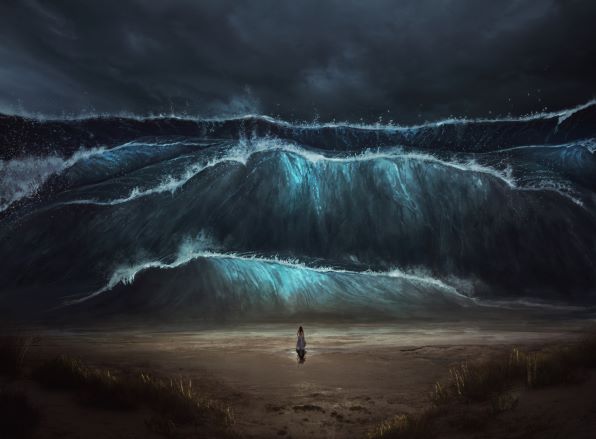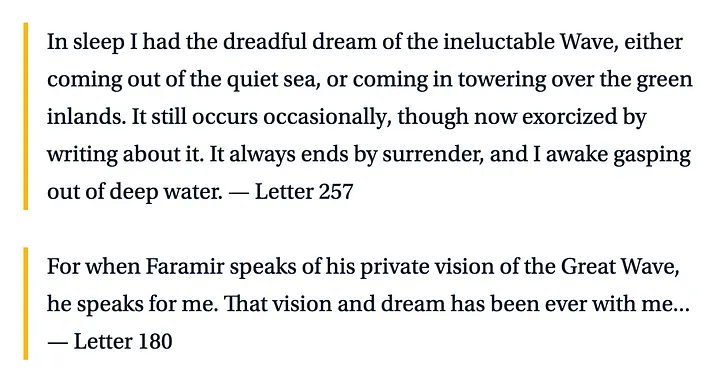Why do we like catastrophes ?
An intimate fascination
When I was a child, I had this recurring dream about a huge wave coming towards us all on the beach. It was tall as a building. There was no way anyone could escape. All I could do was to watch it come towards up… and then I always woke up.

The dream stopped coming back. I forgot all about it until, a few years ago, I visited a exhibition about J.R.R. Tolkien, the author of the The Lord of the Rings. And there it was, written on a card I could easily have missed :

So when one of the characters in The Lord of the Rings, Faramir, evokes his dream, or rather nighthmare, about a great wave that destroys and submerges everything, the inspiration behind the scene is not another literary sources but, directly, the author’s own mind. And Tolkien, clearly, felt the idea fascinating.
It reemerged at the beginning of Episode 4 of the Rings of Power series (2022 ; watch the first 10 seconds).
The Rings of Power. Episode 4
An overabundance of material
We do like catastrophes (yes you do too, at a distance). Weird, and yet, so true. This fascination inspires fiction and movies, like Deep Impact (1998, watch trailer below) – yet another big wave combined with a meteor, but this could have been a volcano (think Dante’s Peak (1997), Pompei (2014) or, simply, Volcano (1997)) an earthquake (San Andreas, 2015), a climate breakdown (The Day after Tomorrow, 2004).
Disaster movies seem to be very safe bets for producers. Or else, why would they keep on producing so many of them. But they are far from the only activities who reflect our fascination with things getting savagedly destroyed. Just watch toddlers and children destroying sand castles at the beach, or waiting for the sea to submerge them…

© Trac Vu / Unsplash (detail)
And unfortunately, the news also reflect the attraction of audiences towards natural disasters.
Missing statistics and studies
You might think that such a consistent pattern in human behaviour would have long caught the attention of psychologists or sociologists. But it seems not. Without overlooking my own possible lack of skill in accessing the data, it is likely that this is a very underinvested field indeed.
Where I would have expected a similar overabundance of data regarding expected surges in audiences, I found nothing. Please feel free to contribute.
The deep impact of the most common informative events.
Just a few days ago, the news featured the terrible collapse of buidlings after a 7.8 earthquake in southern Turkey. For a few hours, the images incoming simply showed spectatular collapses. Only after a day or so did the media evoke the bodies and people trapped under the rubble. This narrative did not provoke massive outrage.
This anecdote shows that fascination for the catastrophe comes first; empathy for the victims comes later, as does realization of the economic impact.
The fascination exerciced by catastrophes is a direct effect of the way the mind develops itself.
Explanation
Reinforcement is opposed to disruption. Any event produces either a reinforcement or a disruption. When an event does not reinforce a chain of idea, it actually disrupts it. This occurs because the event differs from previous events and from the resulting anticipation. Disruption manifests itself by a specific reaction of a brain: a higher level of activity, a longer response, and an adaptive reaction and will allow the mind to better anticipate similar events in the future. The disruption, contrary to the reinforcement, modifies the mind. In other words, it informs it.
Only one information is reinforced by all disruptions, the idea of a disruption. This information, this idea, being reinforced more than any other, exercises a superior pull on the mind. Events evoking disruptions, like catastrophes, are extremely attractive.
This structure can be observed in the universal structure of narratives and in the consequences of this structure on human activities.
It can also be observed through specific experiments.